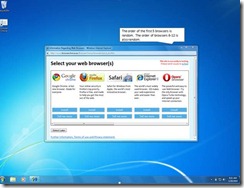News articles
Microsoft offers web browser choice to IE users | BBC Technology (UK)
Microsoft about to offer Windows users a browser choice screen | The Guardian Technology Blog (UK)
La concurrence entre navigateurs web relancée en Europe | DegroupNews (France – French language)
From the horse’s mouth
The Browser Choice Screen for Europe: What to Expect, When to Expect It | Microsoft On The Issues (Microsoft)
UPDATE: The Browser Choice Screen for Europe – Microsoft On The Issues (Microsoft)
European Union press release about the Browser Choice screen
Browser Choice Screen shortcut (available anywhere in the world)
http://browserchoice.eu
Advocacy site
OpenToChoice.org (Mozilla)
My comments and further information
If you run a version of Windows XP, Vista or 7 that you bought in Europe and your default browser is Internet Explorer 8, you may be required to complete a “browser-selection” ballot screen, known as the Browser Choice screen, to determine which browser your computer should run as its default browser. It may not happen if you ran another browser as a default browser, then came back to Internet Explorer 8. It also will happen to European migrants who had brought out their Windows computers with them.
You will have to work through a “wizard” which has an introduction screen then the list of browsers presented in a random order. Once you choose that browser, it will be determined as your default Web-browsing tool every time you go to a Web page. If the browser isn’t installed on your system, the software will be downloaded from the developer’s site and installed in to your system. 
If you run Windows 7, the Internet Explorer “e” logo will disappear from the Taskbar, but you can still find it in your Start Menu. Then, you will be able to reattach it to your Taskbar by right-clicking on the program in the Start Menu and selecting “Pin to Taskbar”.
The Browser Choice screen will subsequently become available as another method of changing default browsers, alongside the options available when you install, update or run a Web browser.
There are some issues you may run into if you move from Internet Explorer 8 to another browser. One is that you won’t have your RSS feeds held in the Common Feed List which works as part of Windows Vista and 7. This may affect the addition of new feeds to programs that make use of the Common Feed List as their RSS data store. Similarly, Windows 7 users won’t benefit from having the tabs viewable in Aero Peek’s multi-window preview. This issue may be resolved with versions of the alternative browsers being built to work tightly with the host operating system’s features, which can be achieved with the Windows application programming interface information being made available by Microsoft.
At the moment, there isn’t a program that adds installed browsers to the shortcut menu when you right-click on a Web link. Such a program would benefit Web developers and bloggers who want to test a page under different browsers or people who want to “spread the Web-viewing load” amongst different clients.
Author recommendations (in no particular order)
I recommend any of these browsers because users don’t have to relearn the user interface if they switch between any of them.
Mozilla Firefox
Internet Explorer
Opera
Safari

